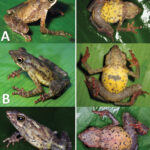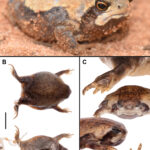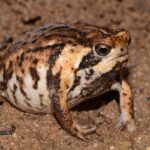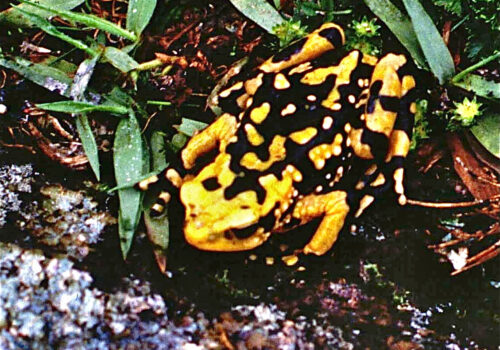- The Enchanting Harlequin Toad: Exploring the Mysterious World of <em>Atelopus orcesi</em>
- Taxonomy and Classification of <em>Atelopus orcesi</em>
- Natural Habitat of <em>Atelopus orcesi</em>
- Physical Characteristics: A Living Jewel of Nature
- Behavior and Life Cycle
- Ecological Role of <em>Atelopus orcesi</em>
- Threats and Conservation Status
- Cultural and Scientific Significance
- Conclusion: A Call to Action
The Enchanting Harlequin Toad: Exploring the Mysterious World of Atelopus orcesi#
Deep within the mist-laden cloud forests of Ecuador, nestled amidst moss-covered branches and bubbling mountain streams, lives a strikingly colored and little-known creature—the Orces’ Harlequin Toad, scientifically named Atelopus orcesi. Known by few but cherished by those who study and protect it, this enigmatic amphibian exemplifies both the beauty and fragility of our world’s biodiversity. As one of Nature’s most curious amphibians, it serves as both a vital part of its ecosystem and a poignant reminder of the delicate balance upon which life depends.
Named in honor of renowned Ecuadorian naturalist Gustavo Orcés, this exquisite species is more than just another amphibian. Its vibrant presence reflects the health and stability of its unique montane habitat, while its troubling decline illuminates the urgent conservation issues that many amphibians currently face worldwide. Let’s delve deeper into the hidden world of the Orces’ Harlequin Toad and uncover why protecting it is vital, captivating, and profoundly meaningful.
Taxonomy and Classification of Atelopus orcesi#
Atelopus orcesi belongs to the family Bufonidae, commonly known as true toads. Within this family, it resides in the charismatic and critically endangered genus Atelopus, known colloquially as the harlequin toads. These amphibians are famous among herpetologists, conservationists, and wildlife enthusiasts alike for their brilliant colors, striking patterns, and precarious status.
Created as a distinct species in 1989 by esteemed herpetologists Coloma, Duellman, Almendáriz, Ron, and Terán-Valdez, Atelopus orcesi was recognized primarily by distinct morphological features and the specificity of its geographic range in Ecuador. Closely related to other high-altitude Atelopus species, Orces’ Harlequin Toad shares trends of decline and vulnerability evident throughout its genus, highlighting the importance of genetic, ecological, and conservation-oriented studies to fully grasp its story.
Natural Habitat of Atelopus orcesi#
Ecuador’s Cloud Forest Jewel#
High amid the Andean slopes of Ecuador, between 2,500 to 3,500 meters above sea level, lies the exclusive, limited habitat of Atelopus orcesi. Surrounded by ever-shifting fog and persistent drizzle, these cloud forests create one of Earth’s most magical atmospheres—an ethereal realm dominated by lush vegetation and dripping moisture. Ferns unfold their emerald leaves alongside bromeliads and orchids blooming vividly amongst thick moss carpeting shapely branches, and through all of this delicate greenery flows crystal-clear, constantly running streams, the very life force of these forests and the irreplaceable home of our harlequin toad.
Orces’ Harlequin Toad favors pristine streamside habitats, choosing areas with ample shaded cover, rocky terrain, and abundant leaf litter. These specific locations aren’t merely picturesque—they offer essential resources crucial to its survival, including protection from predators, adequate humidity, breeding sites, and an abundance of insects upon which to feed.
Physical Characteristics: A Living Jewel of Nature#
Perhaps what first captures one’s attention about Atelopus orcesi is its remarkable appearance. Adults typically measure between 2.5 to 3.8 centimeters in length, and despite this relatively petite size, they possess a vibrant, charismatic appearance that simply demands admiration.
The dorsal surface of this harlequin toad features a striking palette of hues, ranging from vibrant greens or yellows to deep, inky blacks intricately patterned into elegantly blotchy or mottled designs. This bold coloration isn’t mere ornamentation; rather, it’s a vital adaptation. Like other Atelopus species, the bright coloration of Atelopus orcesi is a warning—a phenomenon known as aposematism—informing would-be predators of toxins present within its skin, a defense evolved for survival within its challenging montane environment.
Besides their coloration, the toad’s skin texture remains intriguing. Although traditionally described as smooth, upon closer inspection it reveals subtle granular textures, detailed mosaics that peek through their bright, jewel-like appearance. This delicate blend of pattern and texture creates an enchanting visual display, giving observers the vivid impression of a tiny piece of art plucked straight from nature’s gallery of masterpieces.
Behavior and Life Cycle#
A Secretive Life in Misty Forests#
Atelopus orcesi leads a primarily terrestrial lifestyle, crawling rather than leaping, contrary to what many imagine when thinking of frogs and toads. Its movements are methodically slow, careful, and deliberate—adaptations perfectly suited for navigating the combined terrain of slippery rocks, damp leaves, and twigs, especially necessary in its misty mountainous habitat.
Diet and Feeding Practices#
As insectivores, these harlequin toads prey predominantly on insects that dwell on the forest floor, including ants, beetles, and small flies. With eyesight adapted specifically to swiftly detect prey movement, they are efficient ambush hunters—quiet, still, and patient. Their highly effective tongues snap out within fractions of a second, catching insects in a lightning-quick act of predation that supports their survival in this fragile realm.
Breeding and Reproduction#
The life cycle of Atelopus orcesi is fascinating yet fragile. Breeding typically coincides with seasonal shifts in rainfall, creating optimal conditions in forest streams for egg deposition. Male toads establish territory and call females with soft, almost whisper-like calls, audible only a short distance—a strategy perhaps evolved to minimize predation risk.
Females lay gelatinous egg clutches on submerged rocks in pristine mountain streams, ensuring the developing tadpoles have clean, oxygen-rich environments essential for their survival. Tadpoles rely heavily on crystal-clear water, quickly succumbing in the presence of pollutants or sedimentation—a fact that underscores their ecological vulnerability and emphasizes their sensitivity to environmental change.
Ecological Role of Atelopus orcesi#
This tiny creature plays a surprisingly large role within its cloud forest ecosystem. It functions as a critical predator of insects, contributing directly to balancing insect populations, indirectly fostering vegetational health and forest stability. Additionally, amphibians like Atelopus orcesi serve as prey for various birds, reptiles, and mammals, becoming a central link in their ecosystem’s intricate food web.
Moreover, due to its extreme sensitivity to environmental pollutants and climate change, Atelopus orcesi serves as an indicator species. Its declining population signals ecological disturbances, alerting researchers and conservationists of broader environmental threats—essentially functioning as nature’s early warning system.
Threats and Conservation Status#
A Species in Peril#
The survival story of Atelopus orcesi is currently one of great fragility. The International Union for Conservation of Nature (IUCN) classifies this species as Critically Endangered, with dramatic population declines driven by habitat loss due to agriculture expansion, logging, and human encroachment.
Perhaps more alarming is the devastating spread of chytridiomycosis, a fungal disease that has wiped out entire amphibian populations worldwide. Ecuador’s cloud forests are no exception. This pathogen attacks the amphibian’s skin, impeding its vital physiological processes and swiftly decimating populations.
Conservation Efforts and Hope for Revival#
Conservationists, researchers, and local communities have recognized the urgency of protecting Atelopus orcesi, mounting various efforts to safeguard the habitats it relies upon. Conservation actions include habitat restoration, disease management research, captive breeding programs, public environmental awareness education, and sustained monitoring.
Cultural and Scientific Significance#
Atelopus orcesi holds profound cultural and scientific importance. Locally, it symbolizes the voice of ecosystems humans often overlook—a voice that speaks to the health of the land and rivers. Scientifically, it offers valuable insight into amphibian conservation, disease dynamics, and ecosystem health.
Conclusion: A Call to Action#
Preserving Atelopus orcesi isn’t just about saving a single species—it’s about protecting ecosystems, biodiversity, and the integrity of life systems. As stewards of Earth, we have an ecological and moral responsibility to ensure that our planet remains vibrant. This strikingly beautiful harlequin toad offers us a chance to appreciate nature’s wonders and acts as a stark reminder of conservation urgency—urging us into meaningful action for generations to come.








